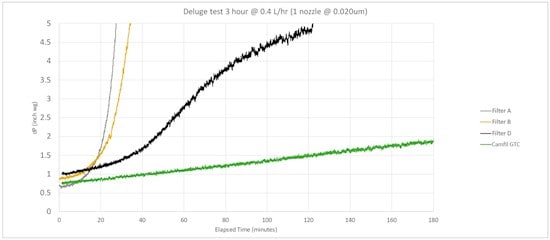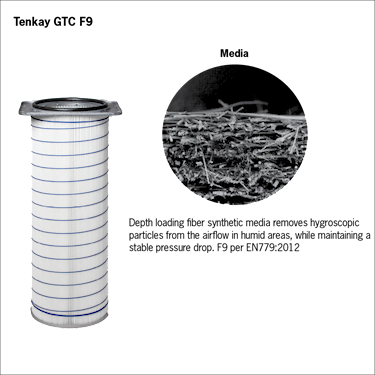The Watson Cogeneration Plant, located within the Los Angeles Refinery Complex, is the largest cogeneration plant in California. The Plant produces 400 MW for local refineries and sells excess electricity to the local utility grid¹. The plant has four GE, Frame 7EA engine that are each equipped with 40" long cartridges installed in an air inlet system.
The plant manager was interested in evaluating different filter efficiencies and media types. While the current E12 filters offered greater engine protection than the previously used M6 filters, the manager was uncertain if they were the optimal solution for the local site conditions and operational needs. Camfil was asked to perform the validation with an on-site CamLab test, followed by an engineering lab analysis.
The plant is situated by a major freeway in an industrial area that is home to large refineries and petrochemical plants. Although a low dust area, the turbines are exposed to small hydrocarbons and fine particulate. Further, the plant is located right by the Pacific Ocean. This exposes the turbines to heavy rolling fog with a high concentration of salt. Sufficient filtration protection is therefore require to prevent degradation, and filter media should handle high humidity and salt.
Each turbine at the plant has 720 cartridge filters, rated E12, which is the highest efficiency class commonly used for gas turbine air inlet filters. In an effort to optimize filtration to the environmental conditions, and to minimize the risk of high pressure drop (dP), the current E12 solution was tested against three lower efficiency products: the Tenkay GTC F9 cartridge filter supplied by Camfil, and two different cartridge filters supplied by other global filter companies.
A CamLab, a portable lab for testing filters, was commissioned on site for 3-months. The measured parameters included airflow, filter dP, filter efficiency, ambient temperature, and ambient relative humidity.
At the end of the test, the four filters were sent to Camfil’s test lab located at the Montreal Test & Learn Center where they were retested to validate the results from the CamLab test.
Pressure drop values in Table 1 indicate that the Tenkay GTC and Filter D had the lowest dP, however, Filter B had a 22% higher dP, while Filter A had a 15% higher dP at the end of the on-site testing.
Once the CamLab results were verified, the filters underwent additional comparative tests at the engineering lab: pre- versus post-discharge efficiency, and a deluge test.
The filters were discharged to indicate their true efficiency class. Table 2 outlines the filters’ discharged efficiency, showing that the Tenkay GTC was the only filter that remained in its efficiency class once discharged.
Finally, a deluge test was performed, where water was misted on each of the loaded filters from the CamLab test. The results show the difference in sensitivity to simulate rolling fog events of the site between the four filters. It also indicates the relative magnitude of the pressure increases that would be expected when seasoned with contaminants and exposed to precipitation over time.
The test was performed until dP across the filter reached 5" w.g. or 3 hrs. had passed, whichever occurred first. The results of the test are shown in Figure 1, indicating that the Tenkay GTC F9 filter was the only one that successfully lasted 3 hrs. and had the lowest dP at 1.9" w.g.
| Filter | Pressure Drop inch w.g. (@700 CFM) |
|---|---|
| Filter A (F9) | 0.79 |
| Filter B (E12) Current |
0.84 |
| Tenkay GTC (F9) | 0.69 |
| Filter D (E10) | 0.69 |
| Filter | Discharged Efficiency (EN779:2012 EN1822:2009) |
|---|---|
| Filter A (F9) | F7 |
| Filter B (E12) Current | E11 |
| Tenkay GTC (F9) | F9 |
| Filter D (E10) | F9 |
Note that for an E10, E11 or E12 filter rating by EN1822:2009, efficiency at the Most Penetrating Particle Size (MPPS: typical range from 0.08-0.15 µm) must be over 85%, 95% or 99.5% respectively on discharged filters.
Note also that for an F9 filter rating by EN779:2012, efficiency at 0.4 µm must be greater than 70%.

| Filter | Test Duration (min) | Water Sprayed (lbs) | Max dP (inch w.g.) |
|---|---|---|---|
| Filter A (F9) | 28 | 27 | 5.0 |
| Filter B (E12) Current | 35 | 31 | 5.0 |
| Tenkay GTC (F9) | 180 | 165 | 1.9 |
| Filter D (F9) | 122 | 98 | 5.0 |
As the overall goal of the test was to determine the impact of reducing the efficiency level at site, several conclusions can be drawn.
The results show that filter efficiency is only one factor to consider when selecting filters. For example, the simulated fog test showed that the current E12 (E11) filter had a very high dP increase. This high dP would likely cause an alarm and a probable turbine trip. The Tenkay GTC filter, however, maintained its F9 efficiency and had a minimal dP increase during the fog event, indicating it may be the better selection for this site. Finally, post-deluge, the GTC’s capability to dry completely implies greater hydrophobicity (resistance to water penetration).
Pulse filters have been supplied all around the world, however, they were originally designed for high dust areas. Traditional pulse filters rely on the formation of a dust cake on the media surface to optimize their efficiency. In coastal environments where salt and other hydrophilic contaminants are present and humidity spikes are frequent, particles in the dust cake can swell on the surface of the filter media, causing high dP.
The GTCs synthetic, 3-dimensional media, and its fine, water repellent fibers that are located in the central layer capture salt particles throughout the depth instead of the surface. This offers low impedance to airflow resulting in lower dP through the filter life.
In addition to the media performance, the HemiPleat® open pleating technology in Camfil cartridges offers wider spacing, exposing more surface media to the air stream. This results in lower overall dP and more importantly, minimal dP increases in high humidity as well as improved dust release during pulse cleaning. Accordingly, low dP will provide operators with the following benefits:

During fabrication of some synthetic filter media, an electric charge is built up, which temporarily increases the initial efficiency of the filter. This temporary charge eventually wears off, and efficiency plummets. In theory, while the electric charge is diminishing, dust particles are accumulating onto the filter, building efficiency back up.
In very high dust areas efficiency increases due to dust build-up on the filter – that dust cake acts as an additional barrier, allowing it to capture smaller particles, therefore increasing average efficiency. In low dust areas, there is often not enough dust to bring back efficiency once the electrostatic charge wears off. This may cause fouling of the blades which may plug the cooling holes of the turbine, or worse, corrosion, which may shorten the life of the turbine blades.
The plant at Watson Cogen, like most coastal sites, has lower dust concentrations, but smaller and finer particulate, therefore, it is important to consider initial discharge efficiency as opposed to only average efficiency when purchasing filters. Always request test reports per EN779:2012 or EN1822: 2009.
1 http://www.decentralized-energy.com/articles/2012/08/tesoro-gain-control-of-californias-largest-chp-plant-after-bp-deal.html